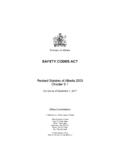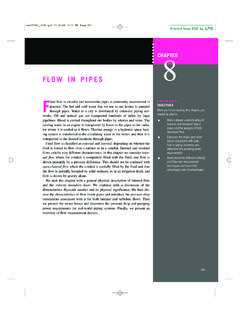Transcription of PROCEDURE FOR DETERMINING THE …
1 THE CITY OF NEW YORK. DEPARTMENT OF ENVIRONMENTAL PROTECTION. Bureau of Environmental Compliance th 59-17 Junction Boulevard, 9 Floor Flushing, New York 11373. PROCEDURE FOR DETERMINING THE THEORETICAL PRESSURE. DIFFERENTIAL REQUIREMENT FOR OIL FIRED COMBUSTION EQUIPMENT. INTRODUCTION. In making a theoretical analysis of the system pressure differentials for a boiler -breeching-stack system, several basic assumptions must be made. These include assumptions for barometric pressure which shall be taken as inches of mercury, the density of air at 0oF and sea level pressure which shall be taken as pounds per cubic foot, and the density of the stack gases at 0oF and sea level pressure which shall be taken as pounds per cubic foot. The temperature of the ambient air shall be taken as 94oF. The volume of gases which are emitted by the boiler is a function of the firing rate and associated theoretical air requirements and excess air used in the combustion process.
2 The more excess air used, the larger the volume of exhaust gases for a given firing rate and the lower the exit gas temperature. The volume rate of flow of the exhaust gas can be calculated from the equation shown in procedures for Calculations, Section 3(a). Assumptions must be made as to exhaust gas temperatures, which may depend on any or all of the following: (a) excess air, (b). boiler design, (c) breeching length, configuration, insulation, (d) stack height, material of construction, exposure. A coefficient of friction in the stack shall be taken as for all types of stack construction, in accordance with the ASHRAE 1972 Handbook of Fundamentals. Be aware that the selection of the proper values for burner oil delivery rate, boiler draft loss, exhaust gas temperatures, theoretical excess air requirements, bend length to diameter ratios, and fan selection have to be based on sufficiently accurate data in order to assure an adequately designed system which is capable of passing a subsequent performance test.
3 PROCEDURE FOR CALCULATION. Plans must include a schematic diagram of the boiler (s) and breeching layout. This diagram must show the bends and the length and diameter of all breeching sections. All bends, changes in breeching area, and/or changes in flow rate in the breeching should be labeled. Page 1 of the calculation sheets will be the summarization of all the friction loses and gains in the system and a method for sizing the induced draft fan, if required. The following directions are to be followed in filling out the attached data sheets. The basis for the following steps can be found in Chapter 25 of the ASHRAE 1972 Handbook of Fundamentals. 1. Enter the boiler draft loss, as specified by the manufacturer, on Page 1. This value should be based on the burner oil delivery rate and excess air requirements which shall be used for the installation. 2. Also enter on Page 1 the burner manufacturer's recommended overfire draft.
4 Care should be taken that the burner manufacturer is fully aware of the type of boiler to which the subject burner shall be connected before he recommends an overfire draft. 3. On Page 2 calculate a friction loss for each bend occurring in the boiler -breeching system, including the bend where the breeching enters the stack. a. Calculate the total volumetric flow rate of exhaust gases according to the following formula: [ ][ ( ) ][ ]. Page 1 of 13. Where, CFM = the total volumetric flow rate of exhaust gases, gph = burner oil delivery rate in gallons per hour Te = exhaust gas temperature which varies from the boiler outlet temperature to gas temperature at chimney outlet, oF. b. Convert bend to its equivalent length. c. Determine the friction loss per 100 feet, based on the CFM passing through the bend and its equivalent diameter. Make the proper corrections for temperature and duct roughness.
5 D. Multiply the two values determined in (a) and (b) above. The product is the friction loss (inches ). e. Add the friction loss caused by each bend and enter the total on Page 1, in the appropriate space. 4. On Page 3 carefully determine the total volumetric flow rate of the exhaust gases (CFM) passing through any length of straight run duct and its equivalent diameter in order to determine the friction loss per 100 feet. Make the temperature and roughness corrections as in 3 (c) above. Multiply this corrected value by the length to obtain the friction loss. Add the friction loss for each length of straight run duct. 5. Area changes are evaluated on Page 4 according to procedures outlined in ASHRAE. Enter on Page 1. total static pressure gains and losses caused by area changes. 6. When other variations in breeching construction occur (such as tees), submit friction loss analyses and enter on Page 1.
6 Some examples of pressure loss in divided-flow fittings are given in ASHRAE. 7. Use the following formula to determine the stack effect: For a Rectangular Stack, [ ]. For a Round Stack, [ ]. Where, Dr = Stack net draft available; inches H = Height of stack; feet Bo = Barometric pressure = in. Hg Wo = Weight of air at 0oF and sea level pressure = .0863 lbs / ft3. Wc = Weight of stack gases at 0oF and sea level pressure = .09 lbs / ft3. To = Absolute temperature of outside air = 460 + 94 (worst condition) = 554oR. Tc = Mean temperature of stack gases; oR. W = Weight of gases generated by boiler and passing through stack; lbs / sec where, [ ][ ( ) ]. and, gph = burner oil delivery rate, gallons per hour F = Coefficient of friction = .016. D = Inside diameter of stack; feet x,y = Cross sectional dimensions of stack; feet Page 2 of 13. Therefore, For a Rectangular Stack, [ ( ) ].
7 For a Round Stack [ ( ) ]. On Page 1, below the summary, show the calculation for DETERMINING the stack effect. Enter the value in the appropriate space in the summary section. 8. Enter a suitable factor of safety to cover uncertainties in exit gas temperature, bend radius and excess air. 9. On Page 1 subtract the total losses from the total gains to see if stack is adequate. 10. Should the total losses exceed the total gains convert this amount to its static pressure equivalent at 70oF (losses were originally calculated at exhaust gas temperature) and determine the proper induced fan required for this static pressure and the CFM going up stack. Note that the location of the fan can affect the CFM, static pressure and exhaust gas temperature. 11. When evaluating multiple boiler installations of the same type, determine losses and gains starting from boiler furthest from stack.
8 (EXAMPLE). When evaluating multiple boiler installations of different firing rates, determine losses from each boiler to stack and use greatest amount in DETERMINING stack adequacy. (EXAMPLE). For example, should stack be adequate for all loops except loop 2, then larger ductwork could be considered. If the difference between the losses is great, an induced fan could be placed between c'. and d', sized according to the volumetric flow rate of flue gases passing through this section at the proper static pressure and 70oF, so as to make up for the inadequacies in this loop. Unless stack is adequate for all loops it is an inadequate stack as far as the total system is concerned. Page 3 of 13. FACTOR. CORRECTION. Fig. 5 ..Correction Factors for Pipe Roughness Page 4 of 13. A D D I T I O N A L E Q U I V. L E N G T H I N T E R M S O F W I D T H. Fig. 6 .. Loss in 90-Deg Elbows of Rectangular Cross Section Page 5 of 13.
9 A D D I T I O N A L E Q U I V. L E N G T H I N T E R M S O F D I A M . Fig. 7 ..Loss in 90-Deg Elbows of Round Cross Section Page 6 of 13. Page 7 of 13. Page 8 of 13. Page 9 of 13. Page 10 of 13. Sample Worksheet Bend Losses Bend Location: Type of Bend: Breeching Equiv. Diameter: Round Breeching: R: ft D: ft R/D: L/D: L: ft Rect. Breeching: R: ft W: ft H: ft R/W: L/W: L: ft Friction loss per 100 ft ( CFM Equivalent Diameter): (refer to ASHRAE) in. ft x (correction for water temp.) x (correction for roughness) = in. Friction Loss(in. ): (Equiv. Length) x (Fric. Loss/100ft)=. Bend Location: Type of Bend: Breeching Equiv. Diameter: Round Breeching: R: ft D: ft R/D: L/D: L: ft Rect. Breeching: R: ft W: ft H: ft R/W: L/W: L: ft Friction loss per 100 ft ( CFM Equivalent Diameter): (refer to ASHRAE) in. ft x (correction for water temp.) x (correction for roughness) = in. Friction Loss(in.)
10 : (Equiv. Length) x (Fric. Loss/100ft)=. Bend Location: Type of Bend: Breeching Equiv. Diameter: Round Breeching: R: ft D: ft R/D: L/D: L: ft Rect. Breeching: R: ft W: ft H: ft R/W: L/W: L: ft Friction loss per 100 ft ( CFM Equivalent Diameter): (refer to ASHRAE) in. ft x (correction for water temp.) x (correction for roughness) = in. Friction Loss(in. ): (Equiv. Length) x (Fric. Loss/100ft)=. Total Friction Loss Due to Bends: in. Page 11 of 13. Straight Run Friction Losses Length of Straight Run Duct: ft Equivalent Diameter: in. Friction Loss per 100 ft. CFM Equiv. Diameter): (ASHRAE) x (Correction for Temperature) x (Correction for Roughness) = in. ft. Friction Loss: (Equiv. Length)x (Fric. Loss/100 ft.)= in. Length of Straight Run Duct: ft Equivalent Diameter: in. Friction Loss per 100 ft. CFM Equiv. Diameter): (ASHRAE) x (Correction for Temperature) x (Correction for Roughness) = in.













